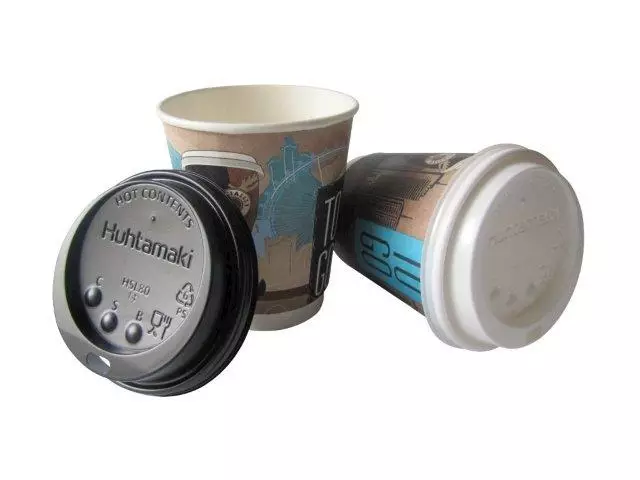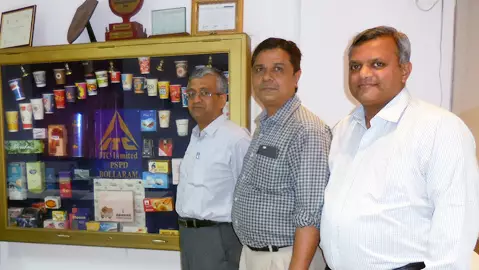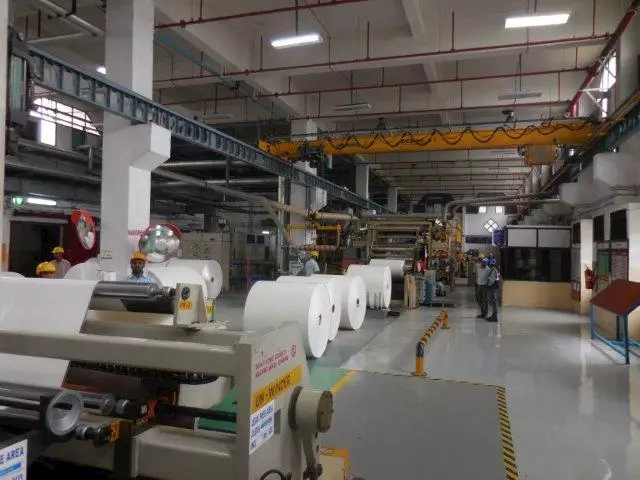A few years ago, while in England, I visited a paper cups producer. These days, they boast of a gearless flexo press with an operating speed of 450m/min, which is able to splice reels on the fly. The main idea was to produce many more paper cups, ensure set-up waste is low and reduce the amount of cleaning required and improve registration.
The reasons for these levels of efficiency: clients wanted to offer much faster turnaround times. So the cups printed from the new factory can be delivered within three to five days, compared to around three weeks for orders that have to be air-freighted from China.
The other thing was: the nimbleness to produce paper cups in the range of one thousand to an excess of one million paper cups.
I have mulled over the future of paper cups in India. Especially in a country where we have a tradition of kumbhars (potters); steel tumblers; and an infant takeaway market.
Does that make the new-age paper cup redundant?
I visited a few factories in Hyderabad and later Kolkata and Bengaluru. These are very small operations with Taiwanese and Chinese machines plus an employee strength of five to ten. There are 3,000 such units in India. But even in those days, most of the company’s turnovers had doubled, and most companies were hiring additional members of staff.
Paper cups – at a glance
Just a quick look at the big specs. The Indian disposable cups market was 60 billion cups per year in 2014-15. Out of this paper cups are close to 15 billion and the balance is plastic. Plastic cups are predominantly made from high-impact polystyrene (HIPS).
Today, the market for paper cups has grown from 15 billion to 25 billion per year.
This is a reason for the movement at top of the pyramid. In 2016, Finnish packaging major Huhtamaki entered the Indian food service packaging market with the acquisition of 51% stake in a Mumbai-based manufacturer of paper cups, ValPack Solutions.
At the time of acquisition, ValPack supplied a range of paper cups which include cold cups, hot cups, ripple cups, ice-cream cups, and lids from small to large sizes for both domestic and international market.
In addition to this, the company also manufactured disposable poly-coated paper cups in various sizes and high impact polystyrene lids which are used for both hot and cold beverages apart from other foodservice packaging products.
Meanwhile, the Japanese paper and pulp giant Nippon Paper is poised to enter India through the acquisition of Plus Paper Foodpac. The deal according to market reports is expected to be Rs 100-crore.
Plus Paper which operates two factories in India boasts of KFC and other fast-food chains on its roster. The Japanese behemoth intends to use its manufacturing knowledge to boost factory productivity and quality.
Plus there are companies like Ashima in Delhi which produces paper cups ranging from 100 ml to 1,000 ml for all the top brands. Then there is World Star in Delhi which produces 100% bio-degradable paper cups in the range from 100ml to 650ml.
In the West Region, some of the names to look out for are Paricott, Express Foods, and Vecchio.
Bottom of the paper cup pyramid
At the bottom of the pyramid are the thousands of units.
A visit to the PackPlus show from 3 to 6 August 2017 at Pragati Maidan and one will be able to see machine demos of the Rs 5-15 lakhs paper cup-making machines; as opposed to the multi crore investments in the European counterparts. These are machines which are manufactured by AKR Machinery, Elegant International, Pritul Machines, Vardhman Packaging. They provide an insight as to why this is a great space as a start-up. Small and compact machines with nimble operations and a guaranteed ROI.
But there is more to it than money. There are two additional reasons for the interest in paper cups.
One is the ban on plastic cups by a few state governments. And so, even the humble roadside chai is served in 220- to 230-micron paper cup in some towns and city centres . The key difference between plastic and paper cups lies in their environmental impact; the 40-micron plastic cup is detrimental to health.
The other thing is consumption index among the top 200 Indian cities. The past five years has witnessed its fastest growth in travel, multiplexes, retail apparel and restaurants. Today, multiplexes are the fastest-growing consumption segment — and penetration has grown to 65% from 30% in 2011 in the top 200 cities. In addition, 90% of top 200 cities are expected to open a five-star hotel, soon. 50% of top 200 cities have a quick service restaurant (new-age chains). And finally, more than two-thirds of the top 200 cities are yet to have a hypermarket chain in the city.
But the big question is, in real terms, will all this translate into a further rise in paper cup production?
What are paper cups?
According to S N Venkatraman, divisional head of marketing at ITC's paperboards and specialty papers division (PSPD), “Paper cups are made by coating a base paper made from the virgin fibre with a very thin layer of plastic – usually LDPE (~ 6 to 8% by weight) .”
I had the opportunity to visit the ITC factory near Hyderabad which is exclusively dedicated to the manufacturing of its brand called Indobev.
Indobev is based on a paperboard made from 100% virgin fibre sourced from sustainably managed plantations and made on a BRC/IoP line. This is an international certification for manufacturing processes that make material that comes into contact with food. This base board is then extrusion coated with food grade LDPE again in a BRC/IoP certified line.
The board is also free from all kinds of heavy metals and dioxins. The substrate and its manufacturing process ensure that it is fit for direct food contact and conforms to all the norms US FDA, Bfr XXXVI.
Venkatraman explains, “We have chosen a set of quality conscious converters from these and trained them on good manufacturing practices thereby ensuring that the cup is made under safe and hygienic conditions. This set is called the “Indobev Champions Network” and has a pan-India presence.”
Recycling and waste
I bring up the matter of recycling waste with the ITC team.
Again, during my stay in England, I was privy to “the negotiations” between McDonald's coffee cups and Cumbrian papermaker; and what Simply Cups, a paper cup recovery, and recycling scheme achieves.
As a result, a paper cup converter like James Cropper recycles more than 10 million paper cups per week at its reclaimed fibre plant. The plant separates the plastic in the cups from the fibre, so it can be used in the company's finest papers. But the cups are not post-consumer waste; the material is waste from the cup manufacturing process.
According to the papermaker, it is difficult to source suitable used cups as they are typically disposed of with other waste, often away from the point of purchase. And because the cups are polyethylene-coated they are not conventionally recyclable.
Now McDonald's has installed new collection stations in around 150 of its 1,250 UK restaurants, with more to come.
James Cropper will see increased deliveries of the baled cup paper each month as the roll-out occurs.
Is such a thing tenable in India?
Venkatraman says, “The biggest challenge in Indobev (and all paper cups for that matter) is the one of processing the conversion waste and in disposing of the used cups.”
Here ITC looks at the conversion waste i.e paper plus LDPE coated waste which is processed using a drum-pulper technology wherein the LDPE is separated from the fibre. This recovered virgin fibre is used in a paperboard called NeoWhite Bliss – designed for blister packaging and the plastic waste is sent to cement plants for incineration in their boilers and generates energy.
Venkatraman assures me, “The entire life cycle of an Indobev cup is environmentally friendly. An inherent disadvantage with plastic cups is that the material in disposed cups has no value while in paper cups the paper is practically virgin fibre and quite a few recycled paper manufacturers are showing interest in using this fibre as it is better than other white waste. Technologies to convert used cups into briquettes which are used for energy generation are also evolving. This we believe will lead to improved collection mechanisms.”
Increasingly municipal corporations in cities like Bengaluru, Hyderabad, Coimbatore require that all solid waste including paper cups are collected and separately processed for reuse.
As the factory visit concludes, I am told about another solution. This is Omegabev. I am told paper cups made out of Omegabev when collected and disposed of in composting atmosphere are completely biodegraded and do not affect the environment in any way.
The future could see a combination of both these technologies making the paper cup the safest choice.
India’s fast-food market will rise by an estimated 50% from 2015 to reach USD 25.7 billion in 2020, according to Euromonitor International. With a population of 1.3 billion and an annual economic growth rate of over 8%, India has a big potential for the paper and paperboard container market, backed by increased demand in the food service industry resulting from the expansion of the middle-income class. Also, the shift from plastic to paper to alleviate the solid waste problem will support market growth.
Time to look at that paper cup a bit more seriously?





